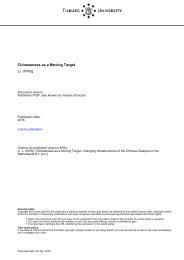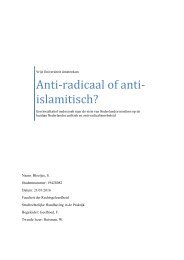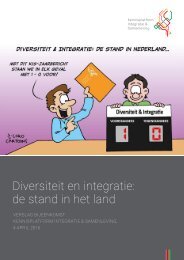Being Trans in the EU – Comparative analysis of EU LGBT survey dataFigure 17: Op<strong>en</strong>ness about <strong>being</strong> <strong>trans</strong> at secondary school, by id<strong>en</strong>tity group (%)EU <strong>trans</strong> average781353Trans wom<strong>en</strong>85934Trans m<strong>en</strong>681977Female cross dressersMale cross dressers66842594 55 3NeverRarelyOft<strong>en</strong>Transg<strong>en</strong>der801163AlwaysG<strong>en</strong>der variant90721Queer/other702073Question:Base:0 10 20 30 40 50 60 70 80 90 100C9. During your schooling before the age of 18, did you ... – A. Op<strong>en</strong>ly talk about you <strong>being</strong> <strong>trans</strong>g<strong>en</strong>der at school?Response categories as listed in the figure (category ‘Does not apply to me’ excluded).Trans respond<strong>en</strong>ts in the EU LGBT survey who felt the question applied to their situation.Source: FRA, EU LGBT survey, 2012Figure 18: Op<strong>en</strong>ness about <strong>being</strong> <strong>trans</strong> at school, by id<strong>en</strong>tity group (%)EU <strong>trans</strong> average3 27 70Trans wom<strong>en</strong>3 19 78Trans m<strong>en</strong>6 34 60Female cross dressersMale cross dressersTransg<strong>en</strong>der4 44 521 23 763 26 72G<strong>en</strong>erally op<strong>en</strong>Selectively op<strong>en</strong>G<strong>en</strong>erally closedG<strong>en</strong>der variant116 83Queer/other2 39 58Question:Base:0 10 20 30 40 50 60 70 80 90 100C9. During your schooling before the age of 18, did you ... – A. Op<strong>en</strong>ly talk about you <strong>being</strong> <strong>trans</strong>g<strong>en</strong>der at school? – B. Hideor disguise that you were <strong>trans</strong>g<strong>en</strong>der at school? Response categories: never, rarely, oft<strong>en</strong>, always, does not apply to me –recoded into the categories as in the figure (respond<strong>en</strong>ts answering ‘Does not apply to me’ were excluded).Trans respond<strong>en</strong>ts in the EU LGBT survey who felt the question applied to their situation.Source: FRA, EU LGBT survey, 2012measures toward equality at work are more widespreadthan positive measure in schools or that – as explainedearlier – people may not be ready to express their <strong>trans</strong>id<strong>en</strong>tity at an earlier age (Figure 19).Those who are curr<strong>en</strong>tly in paid work report considerablymore oft<strong>en</strong> that they were g<strong>en</strong>erally closed insecondary school than those who are curr<strong>en</strong>tly not inpaid work. In addition, those respond<strong>en</strong>ts who havecompleted higher education report significantly moreoft<strong>en</strong> that they were g<strong>en</strong>erally closed at secondaryschool than respond<strong>en</strong>ts with less than higher education.The same t<strong>en</strong>d<strong>en</strong>cy regards income: the higher theincome quartile, the more likely the respond<strong>en</strong>ts were38
Discrimination: experi<strong>en</strong>ces, awar<strong>en</strong>ess, reporting and perceptionsFigure 19: Positive measures and g<strong>en</strong>eral op<strong>en</strong>ness at school (%)Very rare22771Fairly rare32869Fairly widespread32968G<strong>en</strong>erally op<strong>en</strong>Selectively op<strong>en</strong>Very widespread142462G<strong>en</strong>erally closedDon't know22969Questions:Base:0 10 20 30 40 50 60 70 80 90 100C9. During your schooling before the age of 18, did you ... – A. Op<strong>en</strong>ly talk about you <strong>being</strong> <strong>trans</strong>g<strong>en</strong>der at school? – B. Hideor disguise that you were <strong>trans</strong>g<strong>en</strong>der at school? Response categories: never, rarely, oft<strong>en</strong>, always, does not apply to me –recoded into the categories as in the figure.B1. In your opinion, how widespread are the following in the country where you live? – F. Positive measures to promoterespect for the human rights of <strong>trans</strong>g<strong>en</strong>der people (for instance equality plans, public campaigns, specialised services,etc.) Response categories as in the figure.Trans respond<strong>en</strong>ts in the EU LGBT survey who felt the question applied to their situation.Source: FRA, EU LGBT survey, 2012g<strong>en</strong>erally closed in secondary school. It seems as if<strong>trans</strong> people with higher education, higher income andin paid work have a history of <strong>being</strong> closed (or unaware)about <strong>being</strong> <strong>trans</strong> during their schooling years.Experi<strong>en</strong>ce with <strong>trans</strong> hostility at schoolbefore the age of 18Many <strong>trans</strong> respond<strong>en</strong>ts recall a rather negative g<strong>en</strong>eralatmosphere towards LGBT persons at secondary school.Sev<strong>en</strong> in 10 (69 %) indicate they have heard or se<strong>en</strong> negativecomm<strong>en</strong>ts or conduct during their schooling beforethe age of 18, because a schoolmate/peer was perceivedto be LGBT. Almost half of <strong>trans</strong> respond<strong>en</strong>ts (45 %) alsoindicate having heard or se<strong>en</strong> negative comm<strong>en</strong>ts or conductbecause a teacher was perceived to be LGBT.To facilitate further analysis, replies were categorisedinto three groups: those who experi<strong>en</strong>ced a negativeschool atmosphere towards LGBT people (having oft<strong>en</strong>or always heard or se<strong>en</strong> negative comm<strong>en</strong>ts or conductbecause a schoolmate/peer is perceived to be LGBTand oft<strong>en</strong> or having always heard or se<strong>en</strong> negativecomm<strong>en</strong>ts or conduct because a teacher is perceivedto be LGBT), those who experi<strong>en</strong>ced a positive schoolatmosphere towards LGBT people (having never orrarely heard or se<strong>en</strong> negative comm<strong>en</strong>ts or conductbecause a schoolmate/peer is perceived to be LGBTand having never or rarely heard or se<strong>en</strong> negative comm<strong>en</strong>tsor conduct because a teacher is perceived to beLGBT), and the rest, who experi<strong>en</strong>ced a mixed schoolatmosphere towards LGBT people (Figure 20).Figure 20: School atmosphere towards LGBT persons, by id<strong>en</strong>tity group (%)EU <strong>trans</strong> average 244035Trans wom<strong>en</strong> 254233Trans m<strong>en</strong> 284132Female cross dressers 283438Male cross dressers 223542Transg<strong>en</strong>der 244234G<strong>en</strong>der variant 333631Queer/other 214237Positive LGBTschool atmosphereMixed LGBTschool atmosphereNegative LGBTschool atmosphere0 10 20 30 40 50 60 70 80 90 100Question: C9. During your schooling before the age of 18, did you ... – D. Hear or see negative comm<strong>en</strong>ts or conduct because aschoolmate/peer was perceived to be lesbian, gay, bisexual and/or <strong>trans</strong>g<strong>en</strong>der? – E. Hear or see negative comm<strong>en</strong>ts orconduct because a teacher was perceived to be lesbian, gay, bisexual and/or <strong>trans</strong>g<strong>en</strong>der? Response categories: never,rarely, oft<strong>en</strong>, always, does not apply to me – recoded into the categories asin the figure.Base: Trans respond<strong>en</strong>ts in the EU LGBT survey who felt the question applied to their situation.Source: FRA, EU LGBT survey, 201239









